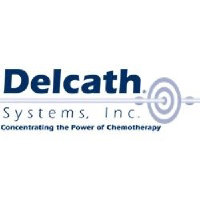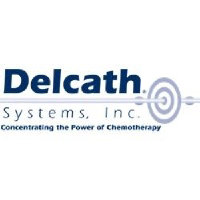
Delcath Systems Inc
NASDAQ:DCTH


| US |

|
Johnson & Johnson
NYSE:JNJ
|
Pharmaceuticals
|
| US |

|
Berkshire Hathaway Inc
NYSE:BRK.A
|
Financial Services
|
| US |

|
Bank of America Corp
NYSE:BAC
|
Banking
|
| US |

|
Mastercard Inc
NYSE:MA
|
Technology
|
| US |

|
UnitedHealth Group Inc
NYSE:UNH
|
Health Care
|
| US |

|
Exxon Mobil Corp
NYSE:XOM
|
Energy
|
| US |

|
Pfizer Inc
NYSE:PFE
|
Pharmaceuticals
|
| US |

|
Palantir Technologies Inc
NYSE:PLTR
|
Technology
|
| US |

|
Nike Inc
NYSE:NKE
|
Textiles, Apparel & Luxury Goods
|
| US |

|
Visa Inc
NYSE:V
|
Technology
|
| CN |

|
Alibaba Group Holding Ltd
NYSE:BABA
|
Retail
|
| US |

|
3M Co
NYSE:MMM
|
Industrial Conglomerates
|
| US |

|
JPMorgan Chase & Co
NYSE:JPM
|
Banking
|
| US |

|
Coca-Cola Co
NYSE:KO
|
Beverages
|
| US |

|
Walmart Inc
NYSE:WMT
|
Retail
|
| US |

|
Verizon Communications Inc
NYSE:VZ
|
Telecommunication
|
Utilize notes to systematically review your investment decisions. By reflecting on past outcomes, you can discern effective strategies and identify those that underperformed. This continuous feedback loop enables you to adapt and refine your approach, optimizing for future success.
Each note serves as a learning point, offering insights into your decision-making processes. Over time, you'll accumulate a personalized database of knowledge, enhancing your ability to make informed decisions quickly and effectively.
With a comprehensive record of your investment history at your fingertips, you can compare current opportunities against past experiences. This not only bolsters your confidence but also ensures that each decision is grounded in a well-documented rationale.
Do you really want to delete this note?
This action cannot be undone.

| 52 Week Range |
3.72
12.64
|
| Price Target |
|
We'll email you a reminder when the closing price reaches USD.
Choose the stock you wish to monitor with a price alert.

|
Johnson & Johnson
NYSE:JNJ
|
US |

|
Berkshire Hathaway Inc
NYSE:BRK.A
|
US |

|
Bank of America Corp
NYSE:BAC
|
US |

|
Mastercard Inc
NYSE:MA
|
US |

|
UnitedHealth Group Inc
NYSE:UNH
|
US |

|
Exxon Mobil Corp
NYSE:XOM
|
US |

|
Pfizer Inc
NYSE:PFE
|
US |

|
Palantir Technologies Inc
NYSE:PLTR
|
US |

|
Nike Inc
NYSE:NKE
|
US |

|
Visa Inc
NYSE:V
|
US |

|
Alibaba Group Holding Ltd
NYSE:BABA
|
CN |

|
3M Co
NYSE:MMM
|
US |

|
JPMorgan Chase & Co
NYSE:JPM
|
US |

|
Coca-Cola Co
NYSE:KO
|
US |

|
Walmart Inc
NYSE:WMT
|
US |

|
Verizon Communications Inc
NYSE:VZ
|
US |
This alert will be permanently deleted.
 Delcath Systems Inc
Delcath Systems Inc
Delcath Systems Inc
Investor Relations
Delcath Systems, Inc. is an oncology company, which focuses on the treatment of primary and metastatic liver cancers. The company is headquartered in New York City, New York and currently employs 45 full-time employees. The company went IPO on 2000-10-19. The firm's lead product candidate, the HEPZATO KIT (melphalan hydrochloride for injection/hepatic delivery system) is a drug/device combination product. HEPZATO KIT is designed to administer high-dose chemotherapy to the liver while controlling systemic exposure and associated side effects. In Europe, its commercial product is a medical device having the same device components as the HEZPATO KIT but without the melphalan hydrochloride, is designated as a Class III medical device, and is sold under the trade name CHEMOSAT Hepatic Delivery System for Melphalan (CHEMOSAT), where it is being used at various medical centers to treat a range of cancers of the liver. In the United States, HEPZATO KIT is considered a combination drug and device product. The firm's product administers concentrated regional chemotherapy to the liver.

Delcath Systems, Inc. is an oncology company, which focuses on the treatment of primary and metastatic liver cancers. The company is headquartered in New York City, New York and currently employs 45 full-time employees. The company went IPO on 2000-10-19. The firm's lead product candidate, the HEPZATO KIT (melphalan hydrochloride for injection/hepatic delivery system) is a drug/device combination product. HEPZATO KIT is designed to administer high-dose chemotherapy to the liver while controlling systemic exposure and associated side effects. In Europe, its commercial product is a medical device having the same device components as the HEZPATO KIT but without the melphalan hydrochloride, is designated as a Class III medical device, and is sold under the trade name CHEMOSAT Hepatic Delivery System for Melphalan (CHEMOSAT), where it is being used at various medical centers to treat a range of cancers of the liver. In the United States, HEPZATO KIT is considered a combination drug and device product. The firm's product administers concentrated regional chemotherapy to the liver.





























 You don't have any saved screeners yet
You don't have any saved screeners yet
